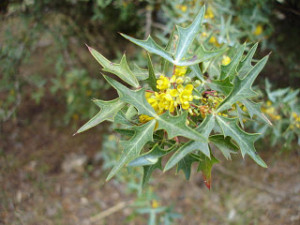 By Sheryl Kleinschmidt, Master Gardener
By Sheryl Kleinschmidt, Master Gardener
I don’t know whether or not Jimmy Buffett ever went to Agaritaville, but if he’d ever tasted the wine, I’m sure he’d return and play his six-string for us!
The first time I can remember seeing agarita (Berberis trifoliate), was at my great uncle’s ranch down in south Texas on the Nueces River. The landscape there reminds me a lot of Somervell County except there are no hills—it’s as flat as a pancake. The caliche soil there lends itself to the proliferation of agarita just as the shallow limestone soil does here.
Uncle Louis was an old-time rancher who lived off the land as much as possible. I can remember being intrigued by some of the things he would show and tell me from time to time when I visited him. Once he showed me the agarita shrubs and told me that he and his family had always collected the little, red berries by placing an old sheet under the bushes and beating them with a stick. But, it was a game of cat and mouse to get to the berries before the birds ate them all!
His family would then either make homemade jelly or wine, which they coveted. It took a lot of those tiny berries to make enough juice for either.
Agarita grows 3’-6’ tall with a spread about the same size. Its foliage is bluish-green and resembles holly. Small yellow flowers begin to develop some time around February attracting honeybees and butterflies alike. The red fruit sets not long thereafter.
Being a Texas native, agarita requires little water. The deer do not like its prickly leaves, but they make a good habitat for nesting birds.
If you are fortunate enough to have agarita on your property (or a friend’s) you might develop a real palate for either the wine or the jelly. Below is a recipe for agarita jelly which is stored in the freezer rather than put into a water bath and canned.
AGARITA JELLY
Gather enough berries to make two quarts. Wash thoroughly, removing any debris such as leaves, stems, etc. Put berries into a large pot and cover with water. Bring to a boil and steep until the berries begin to pop open. Remove from the heat. Using a potato masher, squash the juice out of the berries.
In another pot, bring 4 cups agarita juice to a boil. Add 3 cups of sugar, let it come to a boil again, then add one box of No-Sugar Needed Fruit Pectin. Boil for one minute, cool and pour into freezer containers. Keep frozen til needed.
~****~
“Wasted away in Agaritaville,
Searchin’ for my last spoonful of jel-ly….”